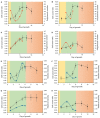Influence of Carbon Sources on the Phenolic Compound Production by Euglena gracilis Using an Untargeted Metabolomic Approach
- PMID: 35740922
- PMCID: PMC9221438
- DOI: 10.3390/biom12060795
Influence of Carbon Sources on the Phenolic Compound Production by Euglena gracilis Using an Untargeted Metabolomic Approach
Abstract
Industrial development and urbanization has led to the diverse presence of metals in wastewater that are often improperly treated. The microalgae Euglena gracilis can tolerate high concentrations of metal via the excretion of organic metabolites, including phenolics. This study aims to evaluate how carbon amendment stimulates phenolic compound production by E. gracilis. The number, relative intensity and molecular composition of the phenolic compounds were significantly different between each of four carbon amended cultures (i.e., glutamic acid, malic acid, glucose, reduced glutathione) during the log phase. Phenolic compounds were mainly produced during the minimum growth rate, likely a response to stressful conditions. A better understanding of phenolic compounds production by E. gracilis and the impact of growth conditions will help identify conditions that favor certain phenolic compounds for dietary and metal chelation applications.
Keywords: Folin–Ciocalteu method; euglenoids; glutamic acid; metabolites; polyphenol.
Conflict of interest statement
The authors declare no conflict of interest.
Figures




Similar articles
-
Molecular changes in phenolic compounds in Euglena gracilis cells grown under metal stress.Front Plant Sci. 2023 May 9;14:1099375. doi: 10.3389/fpls.2023.1099375. eCollection 2023. Front Plant Sci. 2023. PMID: 37229138 Free PMC article.
-
Metabolomic analysis and pathway profiling of paramylon production in Euglena gracilis grown on different carbon sources.Int J Biol Macromol. 2023 Aug 15;246:125661. doi: 10.1016/j.ijbiomac.2023.125661. Epub 2023 Jul 1. Int J Biol Macromol. 2023. PMID: 37399871
-
Metabolic responses of Euglena gracilis under photoheterotrophic and heterotrophic conditions.Protist. 2024 Jun;175(3):126035. doi: 10.1016/j.protis.2024.126035. Epub 2024 Apr 18. Protist. 2024. PMID: 38688055
-
Molecular tools and applications of Euglena gracilis: From biorefineries to bioremediation.Biotechnol Bioeng. 2020 Dec;117(12):3952-3967. doi: 10.1002/bit.27516. Epub 2020 Aug 6. Biotechnol Bioeng. 2020. PMID: 32710635 Review.
-
The biomolecules of Euglena gracilis: Harnessing biology for natural solutions to future problems.Protist. 2024 Aug;175(4):126044. doi: 10.1016/j.protis.2024.126044. Epub 2024 May 23. Protist. 2024. PMID: 38823247 Review.
Cited by
-
Molecular changes in phenolic compounds in Euglena gracilis cells grown under metal stress.Front Plant Sci. 2023 May 9;14:1099375. doi: 10.3389/fpls.2023.1099375. eCollection 2023. Front Plant Sci. 2023. PMID: 37229138 Free PMC article.
-
Microalgal Phenolics: Systematic Review with a Focus on Methodological Assessment and Meta-Analysis.Mar Drugs. 2024 Oct 7;22(10):460. doi: 10.3390/md22100460. Mar Drugs. 2024. PMID: 39452869 Free PMC article.
-
Biodegradable Films with Polysaccharides, Proteins, and Bioactive Compounds from Lobosphaera sp.: Antioxidant and Antimicrobial Activities.Foods. 2025 Apr 11;14(8):1327. doi: 10.3390/foods14081327. Foods. 2025. PMID: 40282729 Free PMC article.
References
-
- Zhou Q., Yang N., Li Y., Ren B., Ding X., Bian H., Yao X. Total concentrations and sources of heavy metal pollution in global river and lake water bodies from 1972 to 2017. Glob. Ecol. Conserv. 2020;22:e00925. doi: 10.1016/j.gecco.2020.e00925. - DOI
-
- Bulgariu L., Bulgariu D. Bioremediation of toxic heavy metals using marine algae biomasse. In: Lichtfouse E., Schwarzbauer J., Robert D., editors. Green Materials for Wastewater Treatment. Springer; Berlin/Heidelberg, Germany: 2005. pp. 69–98. - DOI
Publication types
MeSH terms
Substances
LinkOut - more resources
Full Text Sources

